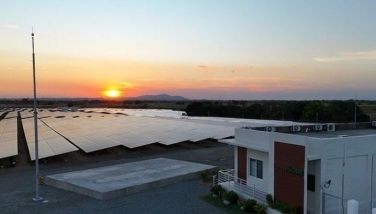Something fishy at the DPWH

It looks like the Department of Public Works and Highways is up to its old tricks again. This time, involving the Laguna Lakeshore Road Network Project, Phase 2.
For those unaware, the project involves the construction of a 24.5-kilometer highway, a 42.8-kilometer bridge or viaduct section and a 2.15-kilometer twin-tunnel section. The highway will have nine interchanges spanning Binangonan to Los Baños.
The project is an extension of Phase 1, a 37.5-kilometer highway that stretches from Bicutan to Calamba.
The ADB already approved a $1.7-billion loan facility for the project. The Asian Infrastructure Investment Bank will participate with a $188.2-million loan. The project is set for completion in 2027.
The DPWH recently released the tender documents last Oct. 8. The tender documents are the basis from which bids of contractors are formulated. What is fishy is that the tender documents were released without a prior roadshow to properly introduce the project to contractors. Naturally, reputable contractors were caught unprepared to participate in the bidding process. Worse, the DPWH set the deadline for the initial submissions on Nov. 26, later extended to Dec. 17. Even the new deadline does not give ample time for contractors to formulate a proper bid.
Exacerbating matters is that the bidding documents provided by the DPWH lacked vital data on soil conditions. This is critical since the project is located in a geologically complex site. And while the project requires extensive environmental approvals, crucial documents like the Environmental Impact Assessment and the Environmental Compliance Certificate were not provided. Even the reports on community and fisherfolk impact were absent.
Without complete data, how can contractors formulate a competitive bid? Reputable contractors will naturally bow out or price their bids too high to provide allowances for the unknown.
The bidding documents clearly favor Chinese contractors who are accustomed to building without proper soil analysis (thus making them susceptible to construction defects) and ignoring environmental and community impacts.
Is this how the DPWH is weeding out reputable contractors in favor of Chinese contractors? We’d like to think that the DPWH, under Sec. Manuel Bonoan, will not allow the corrupt practices of past administrations to fester under the Marcos government. If so, he will do this administration a great disservice as this issue will surely blow up.
We also assume that the secretary realizes the security risk of having an army of Chinese nationals working in our backyard. We have already been infiltrated by Chinese operatives from Beijing who function as spies. It is only prudent that Sec. Bonoan take adequate precautions.
That said, the DPWH must level the playing field by providing the complete set of data to bidding contractors and by extending the deadline to at least February.
Red flags are up. Make no mistake, we will be watching the DPWH closely.
* * *
“Tariff is the most beautiful world in the dictionary,” said president-elect Donald Trump numerous times during the campaign trail.
Trump makes no secret of his intention to impose a 10 percent tariff on all American imports regardless of country of origin and a whopping 60 percent tax on imports from China.
The imposition of tariffs is a campaign promise. I am fairly certain it will be among his first acts as president come Jan. 20.
You see, China enjoyed a $823.2-billion trade surplus in 2023, of which $279.4 billion was earned from the United States. Trump wants more balance in trade, especially since the Chinese are notorious for product dumping.
The Chinese rely on manufacturing to keep their declining economy afloat. Hence, China has not scaled down its manufacturing outputs in step with true demand. This has resulted to an oversupply of such products as electric vehicles, iron and steel which China dumps in markets all over the world. Product dumping distorts market prices and edges out local manufacturers in their country. This is why it is regarded as an unfair trade practice.
In fact, the EU, Indonesia, Chile and India have already imposed tariffs to counter Chinese dumping.
Imposing tariffs yields many benefits. It provides protection against dumping, it encourages foreign manufacturers to set up factories in America and it generates a windfall of tax revenues.
But there is a cost. Tariffs can also make goods more expensive. They squeeze out profits of importers who have no option but to operate with thinner margins or pass the tariff costs to consumers.
With pros and cons to consider, I believe the Trump administration will impose tariffs not on all imports but on selected product categories. Garments, for example, will likely be exempt from tariffs. This is because America imports 97 percent of its garments and a 10 percent tariff will not be enough to revive America’s garment manufacturing industry. The same is true for other low-tech consumer goods.
Rather, I see tariffs applied to strategic industries with high technological inputs, particularly targeting China. This includes electric vehicles, industrial goods, high technology electronics and pharmaceuticals. Doing so will help balance America’s trade deficit, raises tax revenues and satisfy Trump’s base of supporters.
China’s response
China has already diverted its exports away from America since the imposition of tariffs during the first Trump presidency. While trade with the US has been on a decline, it is drastically increasing with ASEAN, Brazil, Mexico, Germany, among others.
China will surely retaliate but not by imposing counter-tariffs on American consumer goods. It will do so by choking America’s access to rare earth elements and other critical raw materials such as magnesium, tungsten, graphite, fluorspar and antimony.
We can also expect China to accelerate moving many of its manufacturing plants to Mexico and Vietnam in order to skirt American tariffs.
A fierce trade war and an era of protectionism is upon us.
* * *
Email: andrew_rs6@yahoo.com. Follow him on Twitter @aj_masigan
- Latest
- Trending























